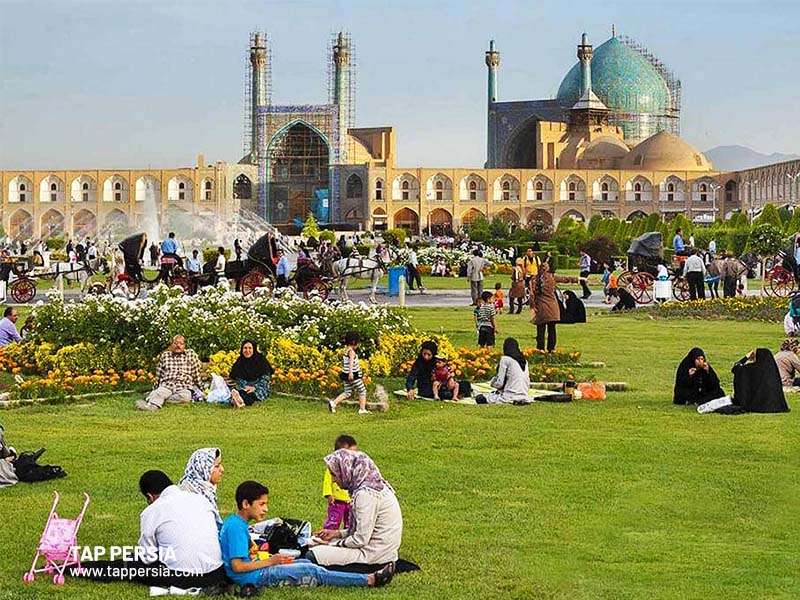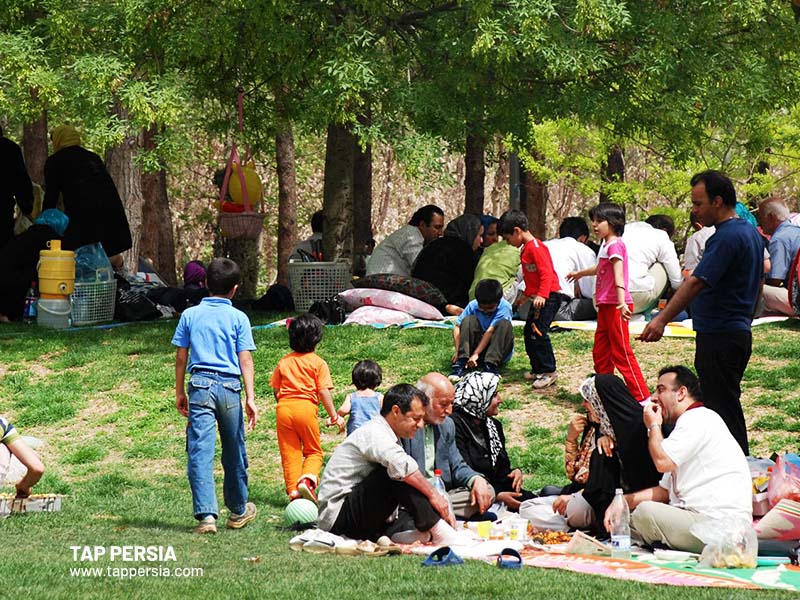Iranian rituals are based on historical occasions, Islamic-era religious beliefs, and prehistoric customs. The majority of ancient Iranian rituals are mystical and seasonal rites that celebrate the relationship between human life and nature.

Examples include appreciating the warmth and brightness of the sun on the longest night of the year, known as the Yalda Night, or giving thanks to mother earth for a good harvest. Nowruz is a holiday honoring the start of spring. The two-week Nowruz vacation in Iran ends with Sizdeh Bedar, one of the most important Iranian festivals that celebrate the natural world. It is observed annually on the 13th of Farvardin (sizdah bedar), the first month in the Persian calendar.
Introduction to Sizdeh Bedar

The main themes of Nowruz, the Persian new year holiday, including respecting plant sprouting and commemorating the renewal of nature in the early spring.
Sizdeh Bedar, which literally translates to “thirteen outdoors on Farvardin 13th” (April 1st or 2nd on the Gregorian calendar), is a last celebration of nature that should undoubtedly follow this old festival. Iranians spend this day camping in the countryside, taking advantage of the fine springtime air and sunshine, socializing with friends and family, dancing, playing music, grilling, and engaging in various outdoor activities.
When is Sizdah Bedar 2023?
Every year, on April 2 (the thirteenth day of Nowruz), Sizdeh BeDar is conducted to signal the conclusion of the Persian New Year celebrations. This year, Sizdeh Bedar will take place on April 2, 2023, on a Sunday.
Origins and History of Sizdah Bedar

Sizdeh Bedar festival’s precise origins are unknown, but we do know that it has roots in mythology and history from ancient Iran. The thirteenth day of Nowruz (Sizdah Bedar) is celebrated in the center of nature because, as per Persian mythology, Jamshid, the monarch of the Pishdadian Dynasty, started doing so by gathering on verdant fields and inviting visitors for numerous years in a row. Moreover, inscriptions from the nearby civilizations of Sumerian and Babylonian refer to a rite similar to Sizdeh Bedar called “Zagmug” that was performed in the middle of nature. These references aid historians in establishing the ritual’s 4,000-year age.
Contrary to popular belief, Sizdeh Bedar is just not practiced in an attempt to fend off the unluckiness of the 13th day, and this number really wasn’t unlucky in ancient Iran. On this day, they sang songs, danced, and sacrificed food in their gardens and fields to honor “Tishtar,” the goddess of rainfall and water. In reality, the 13th of Farvardin marked the beginning of the second half of the crop year.
Zoroastrianism Background
Sizdeh Bedar, according to the Zoroastrian calendar, occurs on April 2—the Tir (or 13th) day of the Farvardin month. The word Tir is a modernized and abbreviated version of the Zoroastrian Avestan names for the brightest star Sirius and the guardian angel of rain and rainwater, respectively, Tishtar and Tishtrya, respectively, in Middle Persian (Pahlavi). Because of this, Zoroastrians make an extra effort to spend the day by a lake or river. A portion from the Tir Yasht will be recited by the pious.
This day also honors the emergence of nature’s richness and the gift of life for Zoroastrians (gaya). Zoroastrians might celebrate Sizdeh Bedar by taking advantage of the chance to renew their commitment to preserve or improve the environment and refrain from defiling any of the seven elements that make up the corporeal creation (gaiety), including fire, air, water, soil, plants, animals, and people.
The Nowruz celebrations come to an end as the sun sets. While the superstitious would believe that the thirteenth day brings ill luck, this is not how Zoroastrian customs work. Perhaps the superstition that it is unfortunate to remain in on the thirteenth was invented to provide the housebound with an extra reason to get out and enjoy the beauty of nature as it emerges in the spring.
Etymology
The number thirteen is seen as unlucky by some Iranians. Sizdeh Bedar, then, is the act of removing the foreboding of the thirteenth day. One method to achieve this is to take a picnic in an area that is surrounded by nature. According to the Dehkhoda Dictionary, “Dar” translates to “valley and plain” and “be” translates to “towards”. In this context, the phrase “Sizdeh Bedar” alludes to setting off on foot on the 13th day for the valley.
Most Popular Tradition on Sizdah Bedar
There are many popular Sizdah Bedar traditions that are unique. The following are some examples:
1.Giving Back the Green Sprout (Sabzeh) to the Nature
Iranians believe that retaining the green wheat sprout (Sabzeh), which they had grown before Nowruz to display on their Haftseen Table, for an extended period of time will bring bad luck, and that it should be returned to nature. As a result, on the day of Sizdeh Bedar, people remove the Sabzeh from their homes and take it out into nature, where they leave it or donate it to a flowing river at the conclusion of their picnic.
This custom also serves as a metaphor for giving gifts to the water deity Anahita. Also, it alludes to an agricultural custom in which Persians would sow many seeds before to Nowruz and see which one grew the fastest until the conclusion of the celebration. Based on whatever crop grew the fastest, they would choose that one as their crop for the next year.
2.To Tie a Knot of Grass

The first person and the founder of the Pishdadian Dynasty was Keyumars, according to Persian creation myth, and his offspring Mashya and Mashyana carried on the human species by their procreation. Mashya and Mashyana celebrated their union by knitting to the green branches of a plant known as Mord since there was no wedding ceremony.
The ancient Persians carried on this custom in a symbolic way for a very long time, and it has been carried on until the present. Making a tie out of grass and wishing for one’s inner desire to be fulfilled is still a significant component of Sizdeh Bedar today, and this tradition has its origins in the enigmatic and lovely ancient mythology. On this day, young boys and girls tie grass and hope for a compatible spouse or even a successful job, while newlywed couples wish for a child.
3.Lie of the Thirteen
The Iranian variant of April Fools’ Day, known as Lie of the Thirteenth (Dorugh-e Sizdah), is celebrated on the first or second of April, on the Sizdeh Bedar holiday. This holiday has apparently been the subject of jokes since the Achaemenid Empire in 536 BC.
Popular Foods and Beverages Served on Sizdah Bedar
There are popular foods and drinks prepared on Sizdeh Bedar that are delicious and magnificent. The following are some examples:
1.Sekanjabin and Lettuce

An extremely old Persian beverage called sekanjabin. It is prepared by the Persians using vinegar, honey, and occasionally mint. While it is highly well-liked in the summer, Sizdah Bedar cannot exist without it. Sekanjabin is consumed with lettuce in Iran. This action symbolizes a resolution to keep healthy in the next year.
2.Ash-e Doogh

One of the classic soups of Ardabil is ash-e doogh, often known as “yogurt soup,” which comes from the Azeri area of northwest Iran. It is a widely consumed meal in a variety of West Asian nations and cultures, including Iran, Azerbaijan, and Turkey.
3.Joojeh Kabab

Most family gatherings and Persian restaurants serve Joojeh Kabab, a low-calorie, keto-friendly meal, with a side of green salad or Persian rice. At Sizdah-Bedar picnics, on the 13th day of Nowruz, and at the conclusion of the Nowruz festival, it is also a common meal item served with bread.
Sizdah Bedar, a Timeless Celebration of Life and Renewal
You may have a deeper understanding of local history and artistic philosophies by learning about rituals, folklore, and beliefs in places with ancient histories like Iran. For instance, touring Persepolis and understanding its visual and symbolic patterns would be enhanced by knowing about Iranian ceremonies like Nowruz and Sizdeh Bedar as well as the significance of natural resources like water and vegetation in ancient Persia.
Nowruz, with its familial customs, strengthens the bonds between people in two ways: through the Chaharshanbe Soori festivities and Sizdah Be-dar meetings, which are both symbols of group togetherness. Hence, the next time you are considering a trip to Iran, be sure to take this time of year into account for an unforgettable experience!
What is the 13th day of Persian New Year?
For Sizdah Be-dar ceremonies, the 13th day of Nowruz, the Iranian New Year, is set apart. Going outside to enjoy nature and spending the day outside are common ways to celebrate it.
What is the origin of Sizdah Bedar?
In this fabulous celebration, people venture outside and spend the day in the great outdoors. Sizdah-Bedar, a symbol of ancient Zoroastrianism, represents nature’s regeneration and the triumph of spring over winter.




Comment (0)